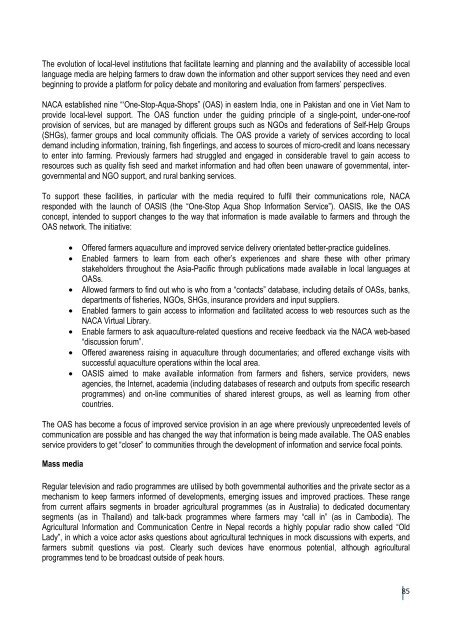Training of Trainers - Library - Network of Aquaculture Centres in ...
Training of Trainers - Library - Network of Aquaculture Centres in ...
Training of Trainers - Library - Network of Aquaculture Centres in ...
- No tags were found...
Create successful ePaper yourself
Turn your PDF publications into a flip-book with our unique Google optimized e-Paper software.
The evolution <strong>of</strong> local-level <strong>in</strong>stitutions that facilitate learn<strong>in</strong>g and plann<strong>in</strong>g and the availability <strong>of</strong> accessible locallanguage media are help<strong>in</strong>g farmers to draw down the <strong>in</strong>formation and other support services they need and evenbeg<strong>in</strong>n<strong>in</strong>g to provide a platform for policy debate and monitor<strong>in</strong>g and evaluation from farmers’ perspectives.NACA established n<strong>in</strong>e “‘One-Stop-Aqua-Shops” (OAS) <strong>in</strong> eastern India, one <strong>in</strong> Pakistan and one <strong>in</strong> Viet Nam toprovide local-level support. The OAS function under the guid<strong>in</strong>g pr<strong>in</strong>ciple <strong>of</strong> a s<strong>in</strong>gle-po<strong>in</strong>t, under-one-ro<strong>of</strong>provision <strong>of</strong> services, but are managed by different groups such as NGOs and federations <strong>of</strong> Self-Help Groups(SHGs), farmer groups and local community <strong>of</strong>ficials. The OAS provide a variety <strong>of</strong> services accord<strong>in</strong>g to localdemand <strong>in</strong>clud<strong>in</strong>g <strong>in</strong>formation, tra<strong>in</strong><strong>in</strong>g, fish f<strong>in</strong>gerl<strong>in</strong>gs, and access to sources <strong>of</strong> micro-credit and loans necessaryto enter <strong>in</strong>to farm<strong>in</strong>g. Previously farmers had struggled and engaged <strong>in</strong> considerable travel to ga<strong>in</strong> access toresources such as quality fish seed and market <strong>in</strong>formation and had <strong>of</strong>ten been unaware <strong>of</strong> governmental, <strong>in</strong>tergovernmentaland NGO support, and rural bank<strong>in</strong>g services.To support these facilities, <strong>in</strong> particular with the media required to fulfil their communications role, NACAresponded with the launch <strong>of</strong> OASIS (the “One-Stop Aqua Shop Information Service”). OASIS, like the OASconcept, <strong>in</strong>tended to support changes to the way that <strong>in</strong>formation is made available to farmers and through theOAS network. The <strong>in</strong>itiative:• Offered farmers aquaculture and improved service delivery orientated better-practice guidel<strong>in</strong>es.• Enabled farmers to learn from each other’s experiences and share these with other primarystakeholders throughout the Asia-Pacific through publications made available <strong>in</strong> local languages atOASs.• Allowed farmers to f<strong>in</strong>d out who is who from a “contacts” database, <strong>in</strong>clud<strong>in</strong>g details <strong>of</strong> OASs, banks,departments <strong>of</strong> fisheries, NGOs, SHGs, <strong>in</strong>surance providers and <strong>in</strong>put suppliers.• Enabled farmers to ga<strong>in</strong> access to <strong>in</strong>formation and facilitated access to web resources such as theNACA Virtual <strong>Library</strong>.• Enable farmers to ask aquaculture-related questions and receive feedback via the NACA web-based“discussion forum”.• Offered awareness rais<strong>in</strong>g <strong>in</strong> aquaculture through documentaries; and <strong>of</strong>fered exchange visits withsuccessful aquaculture operations with<strong>in</strong> the local area.• OASIS aimed to make available <strong>in</strong>formation from farmers and fishers, service providers, newsagencies, the Internet, academia (<strong>in</strong>clud<strong>in</strong>g databases <strong>of</strong> research and outputs from specific researchprogrammes) and on-l<strong>in</strong>e communities <strong>of</strong> shared <strong>in</strong>terest groups, as well as learn<strong>in</strong>g from othercountries.The OAS has become a focus <strong>of</strong> improved service provision <strong>in</strong> an age where previously unprecedented levels <strong>of</strong>communication are possible and has changed the way that <strong>in</strong>formation is be<strong>in</strong>g made available. The OAS enablesservice providers to get “closer” to communities through the development <strong>of</strong> <strong>in</strong>formation and service focal po<strong>in</strong>ts.Mass mediaRegular television and radio programmes are utilised by both governmental authorities and the private sector as amechanism to keep farmers <strong>in</strong>formed <strong>of</strong> developments, emerg<strong>in</strong>g issues and improved practices. These rangefrom current affairs segments <strong>in</strong> broader agricultural programmes (as <strong>in</strong> Australia) to dedicated documentarysegments (as <strong>in</strong> Thailand) and talk-back programmes where farmers may “call <strong>in</strong>” (as <strong>in</strong> Cambodia). TheAgricultural Information and Communication Centre <strong>in</strong> Nepal records a highly popular radio show called “OldLady”, <strong>in</strong> which a voice actor asks questions about agricultural techniques <strong>in</strong> mock discussions with experts, andfarmers submit questions via post. Clearly such devices have enormous potential, although agriculturalprogrammes tend to be broadcast outside <strong>of</strong> peak hours.85
















